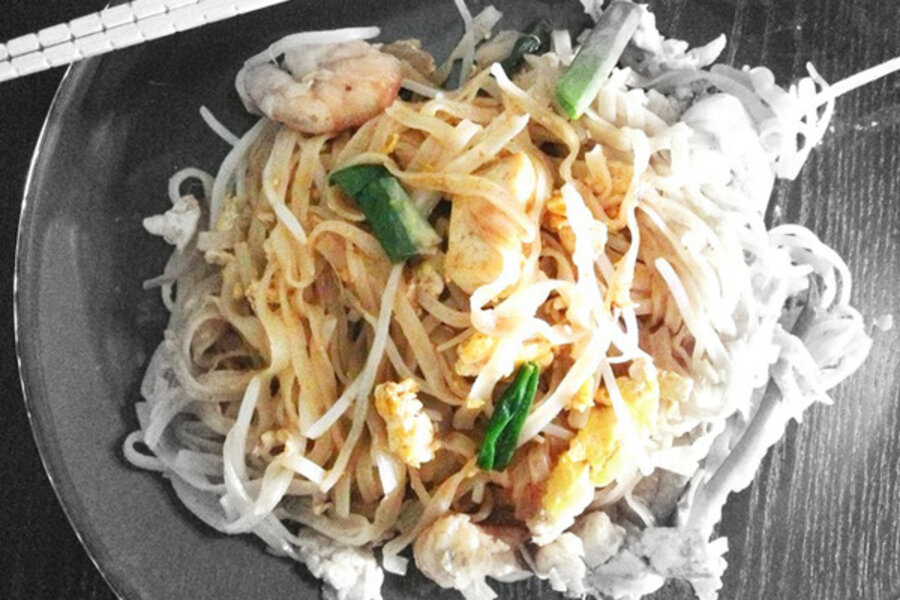By Pat Tanumihardja, Pickles and Tea
Homemade pad Thai sweet and sour sauce in bulk
This will be very messy! Consider yourself warned.
Makes: About 4 cups
Time: 45 minutes
8 ounces wet, (almost) seedless tamarind (half of one 16-ounce package, about 3/4 cup)
Water
1-1/2 cups roughly chopped Thai palm or coconut sugar (6-50 gram discs)
1/4 cup + 2 tablespoons fish sauce
1. Combine the tamarind and 2 cups water in a medium pot. Cook over medium heat for 8 to 10 minutes, stirring, separating and smashing with a wooden spoon until the tamarind turns into a thick and mushy mixture like peach puree.
2. Taking a spoonful at a time, push the mixture through a sieve with your wooden spoon to yield about 1-1/2 cups pulp.
3. Combine the leftover seeds (there will be some seeds!), skin and fiber with 1 cup warm water and stir to release more pulp. Push through the sieve again to yield 1 cup of runnier pulp (my mom taught me never to waste!). The second time will be easier, I promise! You will have 2-1/2 cups of tamarind pulp total. Return to the pot.
4. Add the palm sugar and fish sauce. Bring to a gentle boil over medium heat and simmer about 10 minutes, stirring to dissolve the sugar. Taste and add seasonings to balance the sweet-salty-sour flavors to your liking.
5. Cool and pour into jar – it doesn’t have to be fancy, I use a spaghetti jar. Refrigerate for up to a month and use for pad Thai, to stir-fry shrimp or marinate chicken.
Easy pad Thai
I could write a whole article about rice noodles but I’ll give you the basic need-to-know for the noodles used in pad Thai. Pad Thai noodles are rice noodles, also called rice sticks, made with rice and water, not mung beans not wheat. If you are gluten-free make sure the ingredient list doesn’t include wheat starch.
Rice noodles come in many guises and sizes and what to buy depends on the noodle dish you’re making. For pad Thai, head to the noodle aisle at your Asian market and look for dried rice noodles labeled by their Thai names: chantaboon/jantaboon, sen lek (narrow, as opposed to sen yai, wide), or their Vietnamese moniker: banh pho (size M or L). My favorite brands are Erawan and Three Ladies. Some regular supermarkets also sell the noodles labeled as stir-fry or pad Thai noodles (and they usually carry only one brand, Thai Kitchen, whew) in the Asian/ethnic aisle.
But seriously, if selecting the right noodle gives you a headache, just pick a medium-width rice noodle about the size of linguine (err on the side of wider noodles as too-skinny noodles will break up when you stir-fry) and be done with it. Regardless of size, the noodles will still taste good.
Makes: 2 servings
Time: 20 minutes
2 tablespoons + 1 teaspoon vegetable oil (like peanut or canola)
4 ounces fresh medium shrimp (41/50, about 8 to 10), shelled and deveined
Fish sauce
2 garlic cloves, chopped
1 large shallot or 1/2 small onion, sliced (about 1/2 cup)
2 tablespoons sweet preserved radish, soaked for 5 minutes, squeezed dry and chopped
2 tablespoons dried shrimp, rinsed and chopped
4 ounces fried tofu, cut into 1 by 1/2 by 1/4-inch rectangles
2 eggs
6 ounces dried rice noodles (break off about 1/3 of 16-ounce package), soaked in warm water for 15 minutes, and drained
1/2 cup pad Thai sweet and sour sauce (see recipe above)
4 green onions, chopped into 2-inch lengths (1/2 cup)
1-1/2 cups bean sprouts
Garnishes
1/2 cup crushed roasted peanuts
1/4 cup dry roasted chilies
1 lime, cut into wedges
1. Swirl 1 tablespoon oil into a large wok or pan and heat over high heat until it shimmers. Add the shrimp and sprinkle with 1 teaspoon fish sauce and stir-fry quickly until they turn pink and are almost cooked through, about 1 minute. Remove.
2. Add 1 tablespoon oil. Add the tofu and toss in the wok for a few seconds followed by the garlic, shallot, preserved radish, and dried shrimp, stir-frying a few times in between each addition. Stir-fry for 1 minute, then add the noodles. When the noodles are soft, about 2 minutes, push all the ingredients to one side. Add 1 teaspoon oil to the clearing and break in the eggs. Scramble lightly and when the egg is just about done, break it up with your spatula and toss with the rest of the ingredients.
3. Add the pad Thai sweet and sour sauce and mix well to coat the noodles evenly. Taste and adjust the seasonings. Add more sauce if desired, or add fish sauce to make it saltier or sugar for extra sweetness. If the noodles are too al dente, add water, 1 tablespoon at a time, to soften them up.
4. Turn off the heat and add the green onions and bean sprouts and fry using the residual heat for a few more minutes. Divide onto 2 plates. Serve immediately with garnishes in small dishes.
See the full post on Stir It Up!








